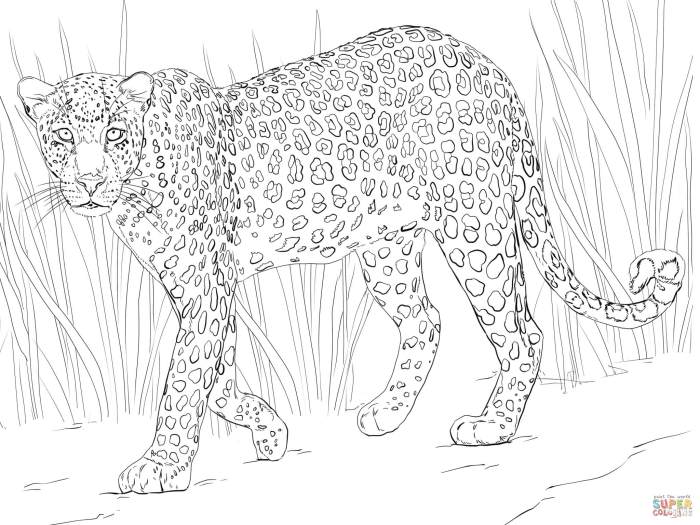African Animals Coloring Sheet Fun & Learn!
Artistic Styles and Techniques: African Animals Coloring Sheet

African animals coloring sheet – Exploring diverse artistic styles and techniques significantly impacts the final aesthetic and emotional impact of your African animal coloring sheets. The choice of style and medium can influence the complexity, accessibility, and overall appeal of the finished product. Careful consideration of these factors will ensure your coloring sheets resonate with your target audience.
Artistic Styles for Depicting African Animals
Different artistic styles offer unique ways to represent the beauty and diversity of African wildlife. Watercolor painting, for instance, allows for soft, blended colors and a fluid, expressive style, capturing the fluidity of movement in animals like cheetahs or the gentle flow of a river alongside hippos. Line art, conversely, emphasizes clean lines and shapes, creating a more graphic and stylized image, suitable for showcasing the intricate patterns of a zebra or the bold silhouette of a giraffe.
Geometric styles, employing shapes and patterns, offer a modern and abstract approach, perhaps ideal for representing the angular forms of a rhino or the tessellated patterns found in nature. Each style offers a different level of detail and complexity, catering to various skill levels and artistic preferences.
Advantages and Disadvantages of Coloring Mediums, African animals coloring sheet
The choice of coloring medium directly affects the final look and feel of the coloring sheet. Crayons, for example, are readily accessible and provide bold, vibrant colors, but they can be difficult to blend smoothly. Colored pencils, on the other hand, allow for greater precision and layering, creating subtle shading and depth, but may require more skill to master. Markers offer intense color saturation and ease of use, however, they can bleed through thin paper and lack the subtlety of colored pencils.
Considering these differences will help you choose the medium best suited to your design and the intended user’s skill level.
Incorporating Texture and Shading
Texture and shading are crucial for adding realism and depth to animal illustrations. Texture can be conveyed through varied line weight, stippling (creating texture through closely spaced dots), or cross-hatching (creating shading using intersecting lines). Shading can be achieved through gradients of color, using darker tones in shadowed areas and lighter tones in highlighted areas. For example, a lion’s mane can be depicted with thick, textured lines and dark shading to emphasize its fullness, while the smooth skin of an elephant can be shown with lighter shading and subtle texture variations.
The use of these techniques transforms a flat image into a three-dimensional, lifelike representation.
Illustrating Various Textures of Animal Fur or Skin
Understanding the unique textures of different animals is essential for creating realistic illustrations. A guide to illustrating these textures might include:
- Elephant Skin: Depict the thick, wrinkled skin using a combination of thick, irregular lines and stippling to show the texture of the wrinkles. Use light and dark shading to accentuate the depth of the wrinkles.
- Lion Mane: Use long, flowing lines to depict the individual hairs of the mane. Vary the line weight and direction to show the movement and texture of the hair. Use dark shading to create depth and volume.
- Zebra Stripes: Use bold, parallel lines to create the sharp, distinct stripes. Maintain consistent width and spacing for a clean, accurate representation. Consider adding subtle shading variations within the stripes to add depth.
- Giraffe Spots: Illustrate the irregular, blotchy spots using rounded shapes. Vary the size and shape of the spots for a more natural look. Use a light Artikel to define the spots and add subtle shading to create a three-dimensional effect.
- Leopard Spots: Use rounded, dark spots on a lighter background. Vary the size and spacing of the spots for a more realistic look. Consider adding a slightly darker Artikel to each spot to enhance their definition.
African animals coloring sheets offer a wonderful way to engage children with the vibrant wildlife of the continent. For a broader selection of exciting creatures, you might also enjoy exploring the diverse range of options available in a comprehensive collection like wild animal coloring pages pdf. Returning to the focus on African animals, remember that these coloring sheets provide a fantastic opportunity for creative expression and learning.


